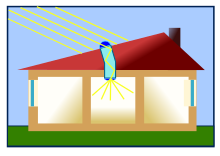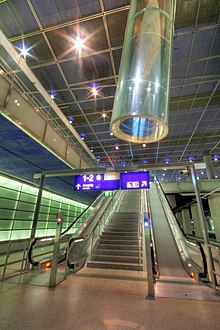Light tube
A light pipe is a daylight system that directs natural light ( sunlight and moonlight ) through a hose or pipe into the interior of a building . Other terms for this are hollow light guides , light tunnels and light chimneys .
history
Daylight tubes (or light tubes, sun tubes or skylights) have their roots in Australia. In the early 1980s, an Australian inventor was working on a further development of the classic skylights. His concept included a system for "capturing" daylight on the roof of a building, which is diverted to a diffuser in the ceiling by a highly reflective cylinder. The first patent was filed in 1986 and four years later a group of Sydney entrepreneurs began manufacturing and distributing this product. The first system was sold in 1991 and became the best-selling skylight in Australia. In 1992 the company expanded to North America and other manufacturers quickly recognized the growing market. There are now a number of manufacturers who manufacture this system in different sizes and types and sell them worldwide.
construction
A transparent glass or acrylic dome is placed on the roof or on the outside wall of the building . From there, the captured light rays are forwarded into the interior of the building via a pipe with very good reflective properties. In the room to be illuminated, a diffusing glass is installed on the ceiling , which distributes the introduced light.
Possible uses
The light tubes allow dark or windowless rooms (for example stairwells, bathrooms, corridors, living rooms and offices) to be illuminated with natural light without additional energy having to be used, as is the case with conventional lighting . Depending on the duration of sunshine , light tubes can improve the energy balance of a building and reduce CO 2 emissions. In addition, the irregular fluctuations in brightness of natural light (cloud cover) meet human viewing habits.
The larger the diameter of the reflective tube, the further the sunlight can be directed into the building. Some manufacturers indicate a possible pipe length of over 20 meters.
There are essentially four factors that determine the light output:
- Pipe diameter : In principle, the larger the pipe diameter, the more light can be transported in the pipe and the fewer reflections the light needs to exit. However, the tube diameter is not solely responsible for the light output of a system. Systems with pipe diameters between 150 mm and 760 mm are currently available on the German market.
- Light receiving surface : The actual daylight receiving takes place via a window or a dome, which is attached to the roof or the facade of a building. A higher light output can be absorbed by domes instead of flat panes. Some improved systems work with an integrated prism structure or a specially calculated lens-like surface structure that increases the daylight-receiving area even further and also directs deep-lying sun rays more effectively into the tube in order to direct more daylight into the light tube. The effective daylight capture surface was therefore defined in the USA in 2008 as a neutral unit of measurement for the daylight capture power in order to be able to compare the systems better.
-
Degree of reflection of the light tube : The daylight absorbed in this way is guided further down through a mirrored tube to the end diffuser. The reflectance of the tubes is therefore an important unit of measurement for the light loss of the system. Especially in winter it is important for systems without optically optimized dome, because then the influence can be clearly felt even with short pipe lengths.
Example: 100% light output comes with a tube diameter of 25 cm, a light tube length of 2 m and the angle of incidence of sunlight = 63 ° (in summer); 42 ° (spring / autumn) or 18 ° (in winter) the following proportions on the lens (or ceiling):- With a reflectance of the light tube of 99.7% still 98.8% (in summer); 97.0% (in spring / autumn) and 94.2% (in winter);
- With a reflectance of the light tube of 98.0% still 92.0% (in summer); 81.7% (in spring / autumn) and 66.8% (in winter) and
- With a reflectance of the light tube of 95.0% still 81.5% (in summer); 59.9% (in spring / autumn) and 35.9% (in winter).
- Scattering of the reflection in the light tube : The influence of the scattering should not be neglected. Diffuse or flexible pipe systems have a greater scattering of the reflection. This is due to the not 100% smooth surface. The spread here is usually 8–10%. Systems with a glued-on (laminated) reflective film have a lower scattering of the reflection due to the process. It is usually 3–5%. The light tubes, which guarantee the reflection with a coating process under vacuum, have a scatter of less than 4% thanks to the use of pure silver. In terms of lighting results, rigid systems are clearly superior to flexible ones. Rigid pipe systems with reflection values of 99.7% or 98% are well suited in summer, and any calculable differences in performance are hardly noticeable with the eye with short (up to 0.5 m) pipe or system lengths. The difference is only noticeable in winter. The different light color (film tends to be bluish, silver tends to be yellow) can also be noticed.
Some systems do not transmit the ultraviolet radiation or the heat radiation of daylight. This is achieved through the use of a special material that only reflects visible light (wavelength between 380 nm and 780 nm). This prevents the rooms from heating up. In addition, the light tubes can be connected to the ventilation system .
Since natural light is not always available, the lighting intensity is subject to fluctuations. For times with little light or in the dark (such as at night), an electrically operated light can usually be built into the light tube.
In the event that the sunlight is too strong, some systems offer covers or blackout options - so-called daylight dimmers.
Energy efficiency
The heat transfer coefficient U (also thermal insulation value , U-value , formerly k-value ) indicates which energy losses can be expected through the installation of the light pipe. In general, care should be taken that when installing the light tube in a roof, the heat transfer coefficient of the tube is approximately the same as that of the roof. Manufacturers often point out that better values can be achieved with a light tube than with roof windows. Not all manufacturers provide precise information on the heat transfer coefficient.
A thermal insulation unit for daylight systems has now been developed. By using multi-pane glasses with argon filling, a U-value of 0.8 W / (m 2 · K) is achieved. This means that daylight systems can also be used in passive or low-energy houses.
More techniques
A similar technique was developed by Australian scientists at the University of Technology, Sydney and is expected to come onto the market under the name "Fluorosolar".
The sunlight can be sent into the light shafts or dark rooms by mirroring and bundling with one or more heliostats (example: construction project in Rattenberg in Tyrol ).
literature
- Sven Kulka: A pipeline for light. In: taz special "Energy & Environment", May 19, 2007
Individual evidence
- ↑ Illustration of a light tube with additional lighting
- ↑ EN ISO 6946 according to Reick, Palecki; see standards and literature
- ↑ Video about the fluorosolar technology
Web links
- Energy efficiency when using daylight from the Daylight and Smoke Protection Association. V. (FVLR eV)
- Technical description of the light tube from the manufacturer of the Berliner Light Tubes at Potsdamer Platz (Heliobus AG)




